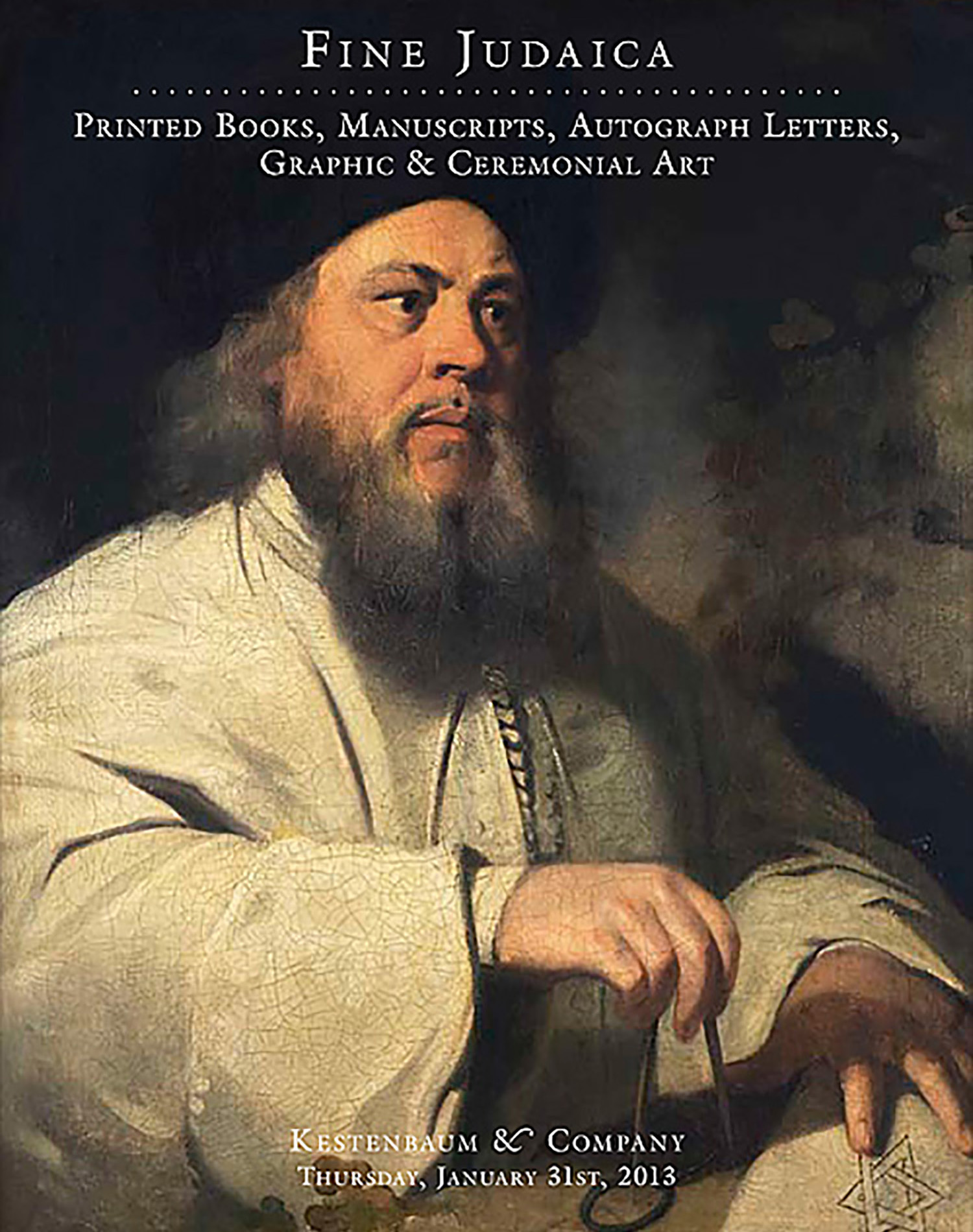Portrait. Attributed to Philip James de Loutherbourg.

AUCTION 57 |
Thursday, January 31st,
2013 at 1:00
Fine Judaica: Printed Books, Manuscripts Autograph Letters, Graphic & Ceremonial Art
Lot 287
HAYIM SAMUEL JACOB FALK, THE BA’AL SHEM OF LONDON.
Portrait. Attributed to Philip James de Loutherbourg.
London, circa 1777:
Est: $30,000 - $50,000
PRICE REALIZED $75,000
<<The celebrated painting of the Baal Shem of London: One of the most well-recognized - and certainly the most famously misunderstood - Jewish paintings.>>
For more than a century, this 18th-century portrait of the Kabbalist Rabbi Dr. Hayim Samuel Jacob Falk, has been broadly misidentified and instead popularly thought of being – still to this day - the founder of the Chassidic movement, the Baal Shem Tov himself.
Moreover, the artist who painted this very painting has also, for many decades, been misattributed to be the celebrated American portraitist John Singleton Copley. The earliest attribution to Copley appears to have been proposed by the historian Lucien Wolf. This appears in Wolf’s Catalogue of The Anglo-Jewish Historical Exhibition of 1887 held at The Royal Albert Hall (item 967a). (Interestingly, in a related essay, the great historian Cecil Roth decries the ignorance of those who have come to identify the portrait as that of the Baal Shem Tov, and yet on the very same page, Roth categorically asserts the picture was painted by John Singleton Copley!).
These errors are well known. What is clearly wanting is a determination, who indeed was the painter of this picture? A very accomplished painting of a most handsome and exotic-looking Rabbi, the type very seldom seen in 18th-century London.
The man himself, Hayim Samuel Jacob Falk, later to be known as the Baal Shem (“Master of the Name”) of London was most likely born in Podolia, Poland circa 1710. He found sanctuary in London in 1742 after narrowly escaping being burnt at the stake by the authorities in Westphalia who charged him with sorcery. Furthermore, the Continent’s chief rabbinical authorities, including Rabbi Jacob Emden, accused Falk of Sabbatianism. Once safely ensconced in London, Rabbi Falk - also known as Dr. Falckon - settled in Wellclose Square in the East End of London, where he established a laboratory for his alchemical studies and led a select group of mystics, both Jew and Gentile. In a travelogue of Rabbi Chaim Joseph David Azulai (commonly, the Chida) a French Marquis and Marquise ask the Chida to pray on their behalf and told him they had already sought out the Baal Shem of London for spiritual healing.
In regard to the painting itself, it has been suggested (anonymously, on the intriguing website ‘On the Main Line’), that the artist who painted Rabbi Falk’s portrait was Philip James de Loutherbourg (1740-1812) a landscape painter and theater-set designer, who possessed a deep interest in mysticism. This he followed via a bond developed with Comte Alessandro di Cagliostro, alias of the occultist and mesmerizer Giuseppe Balsamo (famously implicated in Marie Antoinette’s Affair of the Diamond Necklace). Fleeing Europe for London, di Cagliostro, was active within Masonic circles along with his new friend de Loutherbourg, that were also frequented by Rabbi Falk, whose Kabalistic knowledge and supernatural skills were widely admired. Along with di Cagliostro, Falk is suggested to have been one of the “Unknown Superiors” who were believed to govern high-grade Masonry in 1770’s (see Greer p. 168). To the Encyclopedia of Freemasonry, Rabbi Falk was a most talented thaumaturgist, or, wonder-worker.
The fact is, what appears to be a solemn portrait of a traditional Rabbi, also contains strong Masonic inference. Falk is holding a compass - iconic in Masonic lore. The lower right portion of the painting carries what appears to be a Star-of-David. But in fact it is constructed less as a Jewish iconographic element and more as per a Masonic symbol, representing the combination of the four basic elements of Western alchemy: Earth, Water, Air and Fire - each depicted as triangles with alternate lines passing through.
This would further support a theory that Philip de Loutherbourg was indeed the portraitist, well familiar as he was with such imagery. Thus, de Loutherbourg’s common connection to de Cagliostro, their shared passion for the supernatural and the occult, suggests the likelihood that de Loutherbourg and Rabbi Falk not only were aware of each other, but further, the probability that de Loutherbourg would have painted the Rabbi’s portrait.
<<Provenance:>>
The painting was in Falk’s personal possession upon his death, whereupon it subsequently passed into the custody of the financier Aaron Goldsmid, a patron of Falk. According to Irene Roth (wife of historian Cecil Roth) the painting ultimately found its way back to the descendants of Falk’s star pupil and son-in-law Hirsch Kalisch – now with the Anglicized surname “Collins” - maiden name of Irene Roth’s maternal grandmother. It remained in the Roth household, journeying from Oxford, to Jerusalem, to Manhattan’s Central Park West, until it was acquired following Irene Roth’s death by the late Daniel M. Friedenberg; and subsequently sold in the dispersal of Friedenberg’s collection (Sotheby’s New York, 18th March 2004 Lot 250). The past few years it has resided in a religious museum, but doctrinal differences have insisted that the painting be deaccessioned.
See R.I. Cohen Jewish Icons: Art and Society in Modern Europe (1998) p. 125; J.M. Greer. The New Encyclopedia of the Occult. (2003); R. Patai. The Jewish Alchemists (1994) pp. 454-62; C. Roth, Essays and Portraits in Anglo-Jewish History (1962) pp. 139-65 (esp. 163-4) I. Roth. Cecil Roth, Historian Without Tears. A Memoir (1982).
